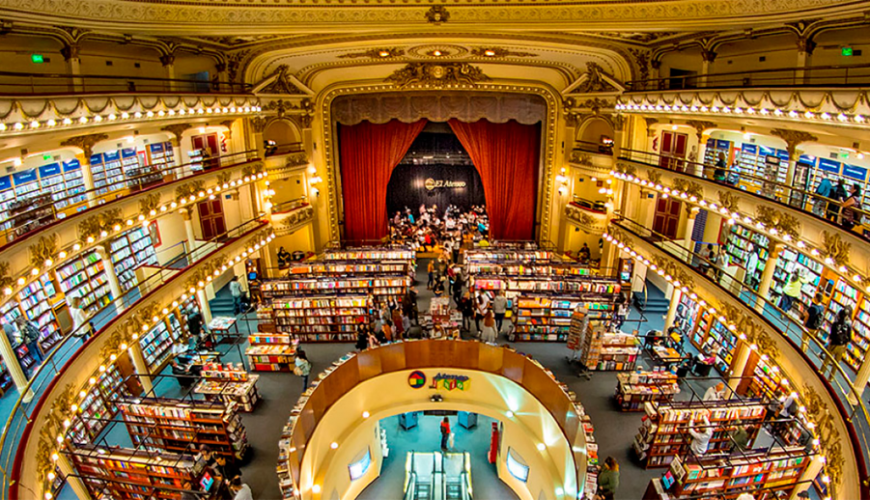What would we offer a foreigner who arrives in Buenos Aires, goes to a bookstore, for example the stunning “El Ateneo Grand Splendid”, on Santa Fe Avenue, and wants to take home a good compilation of Argentinian literature?
With a strong literary tradition, Argentina has produced some of the most famous authors in the world, which creates a small problem for those curious about which titles to address first. The following list is a journey through Argentina´s life as well as an attempt to highlight the essential titles and authors of Argentine literature. From historical to humorous, Argentine writers give you plenty to discover. Most of the titles are available both in English and Spanish editions.
1- Martin Fierro (1872) by José Hernández
Gaucho Martin Fierro is the undisputed classic of gaucho poetry, an Argentine literary icon from the Pampas and its rough lifestyle.
2- Facundo (1874) by Domingo Faustino Sarmiento
This book seeks to use the life of this character as an example to show life in military campaigns, and to show the ideology of an entire political sector at the time in Argentina.
3- Los Siete Locos (1929) by Roberto Arlt
(The Seven Madmen)
While the imagery in this book is detailed and vivid, it is a novel of strong psychological characters and social criticism. With many monologs sometimes hard to follow, his reflexive narrative and stories come from the world of the absurd and without sense with characters hard to forget.
4- La Invención de Morel (1940) by Adolfo Bioy Casares
(The Invention of Morel)
The legacy of this extraordinary writer left a strong influence on Argentine literature. Borges and Bioy wrote in secret complicity being a ghost writer of the other, making their literature a surreal mirror of the same they wrote.
5- El Aleph (1949) by Jorge Luis Borges
(The Aleph)
A book written with authentic literary genius, is the compilation of 17 short stories referred to metaphors and myths from the world´s literature tradition, framing most of these stories on a fantastic but realistic paradox of facts and objects.
6- Zama (1957) by Antonio Di Benedetto
Zama is a perfect book, where the philosophical quality follows naturally from dazzling prose. “Zama is, for certain aspects of his narrative conception, comparable to the major works of existentialist narrative, such as La nausea and El foreigner, and maybe, however, because of the circumstances in which it was written and the peculiar situation of the person who wrote it, Zama is in many ways superior to those books.”
7- Sobre Héroes y Tumbas (1961) by Ernesto Sábato
(On Heroes and Tombs)
Author of very few published works, Sábato destroyed almost everything he wrote during his life. Fortunately, this book, considered one of the most important Argentine books, is an exception. It tells the story of a strange relationship where loneliness, love and fear are the points of contact between the characters. It is a true masterpiece of universal literature.
8- Rayuela (1963) by Julio Cortázar
(Hopscotch)
Set in both Buenos Aires and Paris, it is considered an ‘anti-novel’ and it is an important literary work, representing the bohemian Argentine lifestyle on the 1960s with its own very innovative and unique expressive language.
9- Los Burgueses (1964) by Silvina Bullrich
(The Bourgeoisie)
Entertaining, witty and not complacent, the novel describes the slow decline of the aristocratic upper class in Argentina and how it affected the newer generations.
10- Mafalda (1964 – 1973) by Quino
Joaquín Salvador Lavado Tejón, better known as Quino, is an Argentine graphic and comic cartoonist. His best known work is the comic strip Mafalda, published between 1964 and 1973. In the Mafalda series, Quino reflected the world of adults as seen through the eyes of a group of children. The leading character was an inquisitive, intelligent, ironic, non-conformist girl, concerned with peace and human rights, who hates soup and loves the Beatles.
11- Respiración Artificial (1980) by Ricardo Piglia
(Artificial Respiration)
A novel whose main thread is Emilio Renzi, the protagonist and narrator of three of them, and the other story creates the illusion that it contains the other three. In addition, he uses the imagination as the meeting place between two historical and very different characters such as Hitler and Kafka, and the consequences that this talk could have had.
12 – Los Pichiciegos (1982) by Rodolfo Fogwill
(Malvina´s Requiem)
A novel that tells the story of a group of young Argentine soldiers sent by the military dictatorship who desert and take refuge in an underground cave on an island during the Falklands War. Officially thought to be dead by the Argentine army, they are really hidden inside a cave, called a ¨pichicera¨.
13- Santa Evita (1995) by Tomás Eloy Martínez
(Santa Evita)
A well achieved mixture of real events and fiction, focused on the life of the first Argentine lady Eva Perón, following the story of her death at age 33 and the subsequent destiny of her embalmed body.
14- La Joven Guardia – Nueva Literatura Argentina (2005)
Compilation and prologue by Maximiliano Tomas
(The Young Guard – New Argentine Literature)
This is the first anthology that brings together the new generation of Argentine writers. An extraordinary opportunity to meet those who will undoubtedly become classic writers. It’s a challenging reading with the added pleasure of seeing refreshing new trends in literature.
15- La Gracia de Leer – (Casi) 200 Años de Humor Literario Argentino, by Ariel Magnus
(The Grace of Reading – (Almost) 200 Years of Argentine Literary Humor)
A broad anthology of literary humor, a genre in which many Argentine writers standed out, with predictable names like Soriano, Cancela, Fontanarrosa, Macedonio, and with more surprising ones such as Borges and Bioy. A light and very entertaining reading.
By Patricia C. Prada Jimenez and the Blogs Team




